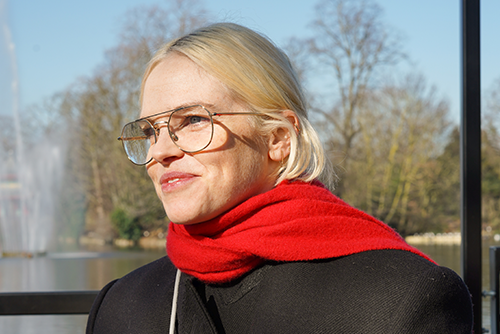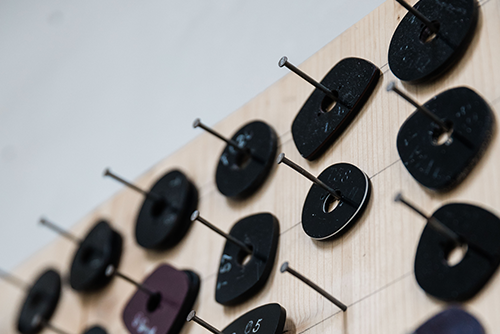Made in: The Wire Frame Workshop
MADE IN: THE WIRE
FRAME WORKSHOP
FINDING THE PERFECT PRODUCTION PARTNER
Over a year ago, we started work on designing our most recent collection in collaboration with Oliver Spencer which would be our very first foray into wire frame design. After a lot of research and many conversations over Zoom, we found the perfect partner to help us bring this collection into the world. Our new wire frame workshop understood our vision, shared our values and offered invaluable support in helping us produce something we could all be proud of.
The result? Frames which have been designed and manufactured with meticulous care and attention to detail, with every step of production process carefully considered.
THE MOST SPECTACULAR OFFICE VIEW
Our new material concepts took us a mere 30km away from our acetate workshop, over to our wire frame factory that we came to use in nearby Venice, nestled into the side of a mountain in the Dolomites overlooking the Italy-Austria border.
KNOWING WE'D MADE THE RIGHT DECISION
Finding the right workshop that could work with the materials we wanted was not something we were prepared to make a snap decision about. This involved visiting a series of workshops, speaking to makers and learning more about the various ways different frames are made.
When we discovered the specialists that we eventually partnered with, we knew they were the perfect fit. The most important thing to us was finding another workshop that shares our values, that has the utmost respect for true craftsmanship and a consciousness of their impact — not just somewhere that could churn out the frames that we needed at the lowest possible cost. This workshop shared our ingrained values in true craft and had an interest and understanding of our story behind the designs.
Makers within the eyewear industry are rarely spoken about and we simply can't understand why. Watching these incredible artisans at work is such an honour and we feel that more people should be able to witness and admire their craft. In light of this, we're sharing who they are and a little bit about them so that you can get to know the craftspeople behind the frames.
LUCA
CO-OWNER - COMMERCIAL & TECHNICAL REPRESENTATIVE
In his spare time Luca loves to go out on his motorbike.
IVET
CO-OWNER - ADMINISTRATION & PRODUCTION MANAGER
Ivet likes to read and spend time with her children.
ERNA
CO-OWNER - LEGAL REPRESENTATIVE & QUALITY MANAGER
In her free time Erna likes reading and gardening.
MARIA
FIXING & SOLDERING OPERATOR
Outside of work Maria Angela loves spending time with her friends.
DENIS
PRODUCTION & TECHNICAL OPERATOR
Denis is a keen football and cycling fan.
ANGELO
FIXING & PRINTING
Angelo is enjoying retirement, but occasionally comes in to help due to his experience and expertise.
CRISTIAN
TECHNICAL & POLISHING OPERATOR
Cristian likes to go jogging in his free time.
CRISTINA
TECHNICAL & SOLDERING OPERATOR
Cristina likes singing and walking in the mountains.
IULIANA
FIXING & TECHNICAL OPERATOR
Iuliana likes to read in her spare time.
ROMINA
TECHNICAL & POLISHING OPERATOR
Romina enjoys foraging for mushrooms as well as spending time with her friends.
DEBORA
FIXING & SOLDERING OPERATOR
Outside of work Debora loves seeing her friends and spending time with her children.
EXPLORE THE WORKSHOP
THERE'S MORE TO IT THAN YOU MIGHT THINK
You might think that all frame components are made in the same place, but the reality is that even the smallest parts can come from across the world. Our choice to collaborate with this workshop was made because they are knowledgeable in their craft and source as locally as possible, choosing components that fulfil our requirements while maintaining the highest quality.
OBSESSING OVER THE DETAILS
It's the details that make our frames what they are. Every single component, no matter how small, is carefully chosen for its exquisite function and durability. If we didn't obsess over the details, we wouldn't be proud of our frames. These are made to last.
PROFILE/ARMS
MATERIAL: MONEL
Hypoallergenic Monel™ contains 68% nickel, 30% copper and 2% iron. Our Monel rims are repairable, highly resistant to corrosion and stronger than steel. (Our Monel rims are repairable, highly resistant to corrosion and very strong—in fact, much stronger than steel).
HOW IS IT MADE?
Our eyewear frame profiles are crafted through a direct extrusion process which heats the Monel block to a temperature of >300°C. A hydraulic press then forces the material through a heated die and the extrusion is curved to the frame profile.
HINGES
MATERIAL: STAINLESS STEEL
Stainless Steel is the most recyclable material on earth and due to its ultra reliable nature it is the industry standard for high quality hinges. Barrel hinges are among the oldest design found in eyewear and have been around almost as long as spectacles themselves.
HOW IS IT MADE?
Stainless Steel hinges are expected to last the lifetime of the frame and are extremely durable, reliable and repairable. Our frames are precision milled from a solid block of Stainless Steel and welded onto our Alpacha triangular temple arm.
NOSE BRIDGE
MATERIAL: MONEL
Hypoallergenic Monel™ (68% nickel 30% copper and 2% iron) - This ductile material which is the most commonly used frame material today is often used for components that require sturdiness and rigidity. Monel is is highly resistant to corrosion and stronger than steel.
HOW IS IT MADE?
The manufacturing process involves forcing molten Monel under high pressure into a reusable precision machined steel die; this mould is capable of producing numerous components in rapid succession. Die casting is the most efficient way to produce high quality dimensionally accurate components such as this.
NOSE PADS
MATERIAL: BRASS
Brass is an alloy made primarily of copper and zinc, it is durable and hygienic making it suitable for frequently touched surfaces and perfect for nose pads.
HOW IS IT MADE?
The nose pad pieces crafted from brass are manufactured through the die-cast process which involves forcing molten brass under high pressure into a reusable precision machined steel die; this mould is capable of producing numerous components in rapid succession. This process is the most efficient way to produce high quality dimensionally accurate components such as this.
TEMPLES
MATERIAL: ALPACA
Nickel silvers also known as "Alpaca" contain more than 50% copper, 25% nickel, and the rest zinc. Copper gives pliability to the material, zinc adds strength and nickel gives the silver appearance. Alpaca was used for the temples due to the triangular design; the triangle is the strongest shape in nature and Alpaca allowed us to create a lightweight construction while maintaining strength.
HOW IS IT MADE?
The manufacturing process involves forcing molten Monel under high pressure into a reusable precision machined steel die; this mould is capable of producing numerous components in rapid succession. The Die-cast process is the most efficient way to produce high quality dimensionally accurate components such as this.
PROFILE/ARMS
MATERIAL MONEL
Hypoallergenic Monel™ contains 68% nickel, 30% copper and 2% iron. Our Monel rims are repairable, highly resistant to corrosion and stronger than steel.
HOW IS IT MADE?
Our eyewear frame profiles are crafted through a direct extrusion process which heats the Monel block to a temperature of >300°C. A hydraulic press then forces the material through a heated die and the extrusion is curved to the frame profile. Our unique batch numbers are then individually engraved onto the end of the arm.
HINGES
MATERIAL: STAINLESS STEEL
Stainless Steel is the most recyclable material on earth and due to its ultra reliable nature, it is the industry standard for high quality hinges. Barrel hinges are among the oldest design found in eyewear and have been around almost as long as spectacles themselves.
HOW IS IT MADE?
Stainless Steel hinges are expected to last the lifetime of the frame due to being extremely durable, reliable and repairable. Our hinges are precision milled from a solid block of Stainless Steel and welded onto our Alpaca triangular temple arm.
NOSE BRIDGE
MATERIAL; MONEL
Hypoallergenic Monel™ (68% nickel 30% copper and 2% iron) - This ductile material is the most commonly used frame material today and is often used for components that require sturdiness and rigidity. Monel is highly resistant to corrosion and stronger than steel.
HOW IS IT MADE?
The manufacturing process involves forcing molten Monel under high pressure into a reusable precision machined steel die; this mould is capable of producing numerous components in rapid succession. Die casting is the most efficient way to produce high quality dimensionally accurate components such as this.
NOSE PADS
MATERIAL: BRASS
Brass is an alloy made primarily of copper and zinc. It is durable and hygienic making it suitable for frequently touched surfaces and perfect for nose pads.
HOW IS IT MADE?
The nose pad pieces crafted from brass are manufactured through the die-cast process which involves forcing molten brass under high pressure into a reusable precision machined steel die; this mould is capable of producing numerous components in rapid succession. This process is the most efficient way to produce high quality dimensionally accurate components such as this.
TEMPLES
MATERIAL: ALPACA
Nickel silvers, also known as "Alpaca", contain more than 50% copper, 25% nickel, and the rest zinc. Copper gives pliability to the material, zinc adds strength and nickel gives the silver appearance. Alpaca was used for the temples due to the triangular design; the triangle is the strongest shape in nature and Alpaca allowed us to create a lightweight construction while maintaining strength.
HOW IS IT MADE?
The manufacturing process involves injecting molten Nickel Silver under high pressure into a reusable lubricated die. Molten Alpaca is inserted under high pressure to stop the material cooling outside of the die. The high pressure environment remains constant as the metal solidifies. The reusable lubricated die is capable of producing precise and dimensionally accurate components continuously.
THE RESULT
The result is a trio of intricately designed frames, crafted by individuals with great care and attention to the finest details, creating eyewear that's set to last a lifetime.
THE RESULT
The result is a trio of intricately designed frames, crafted by individuals with great care and attention to the finest details to create eyewear that's set to last a lifetime.
THE RESULT
The result is a trio of intricately designed frames, crafted by individuals with great care and attention to the finest details to create eyewear that's set to last a lifetime.


